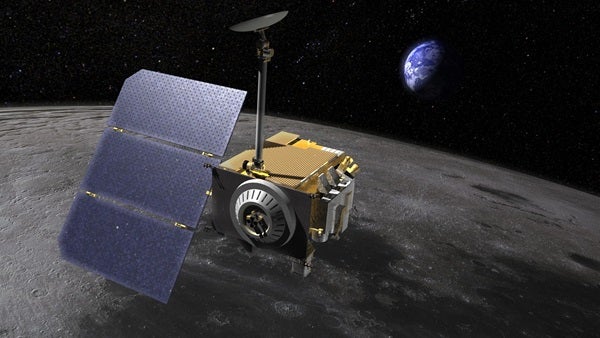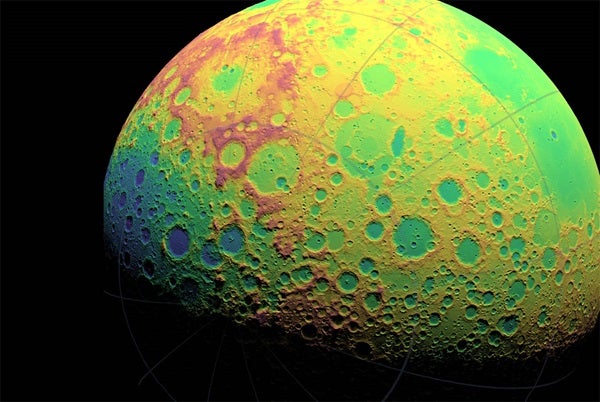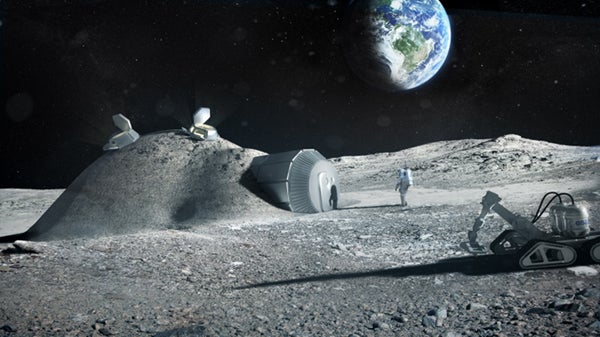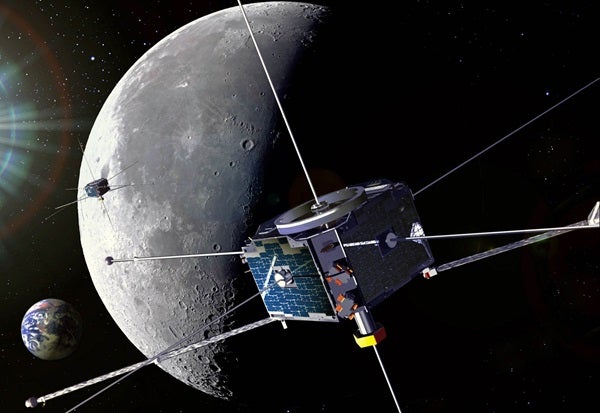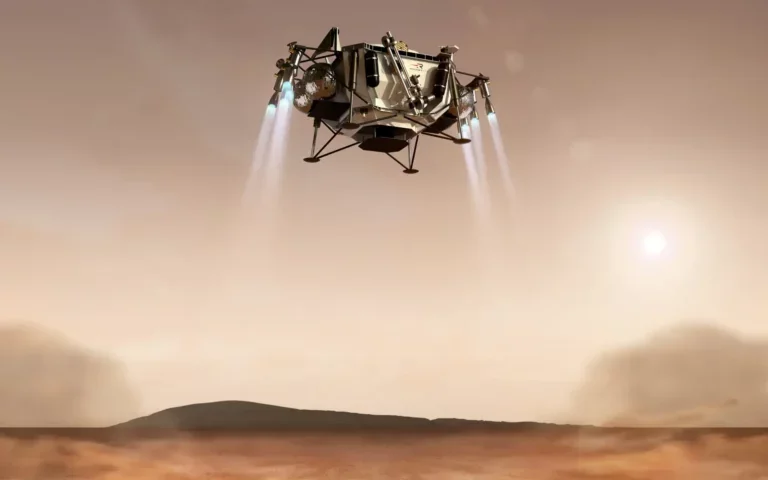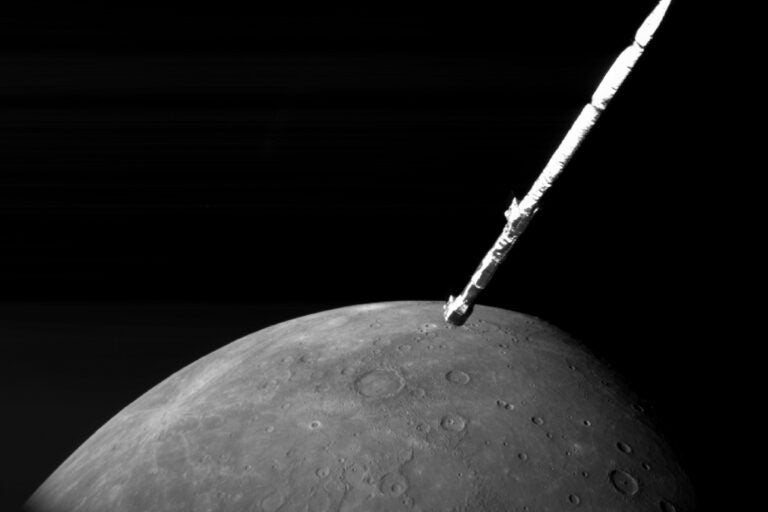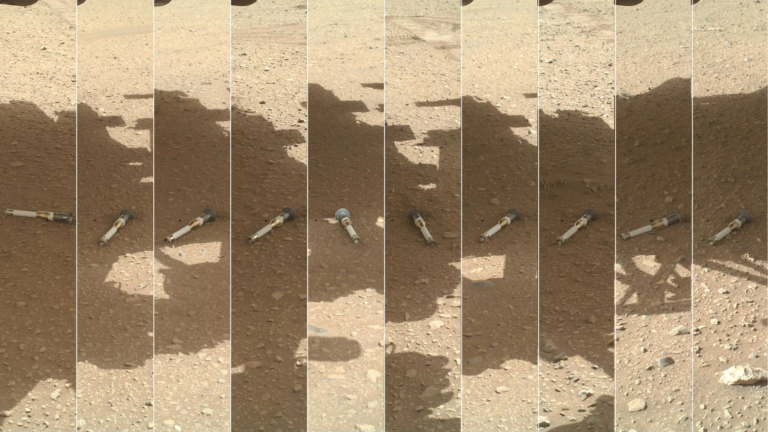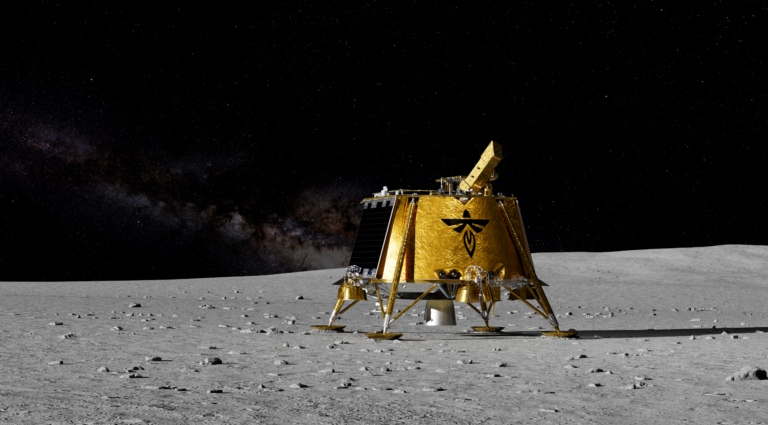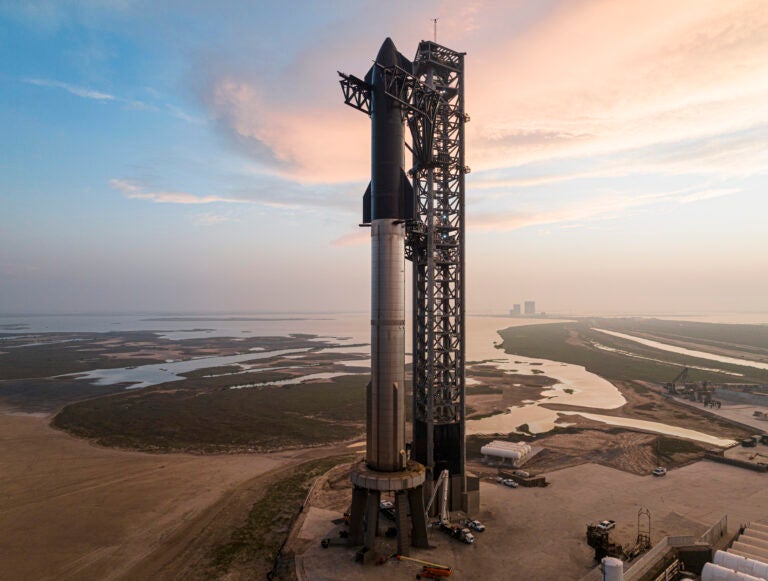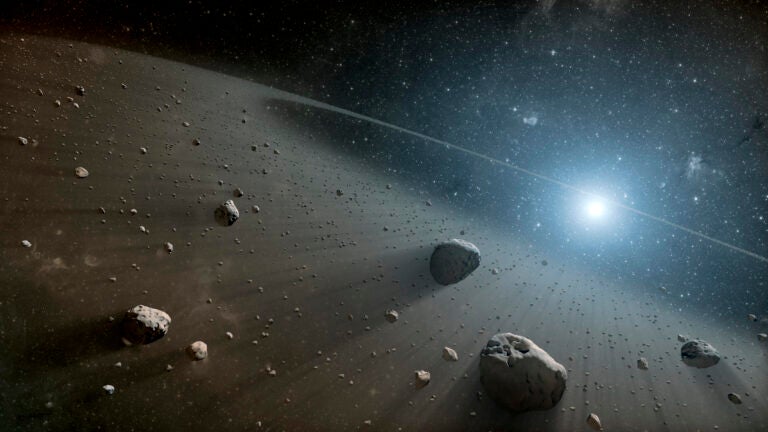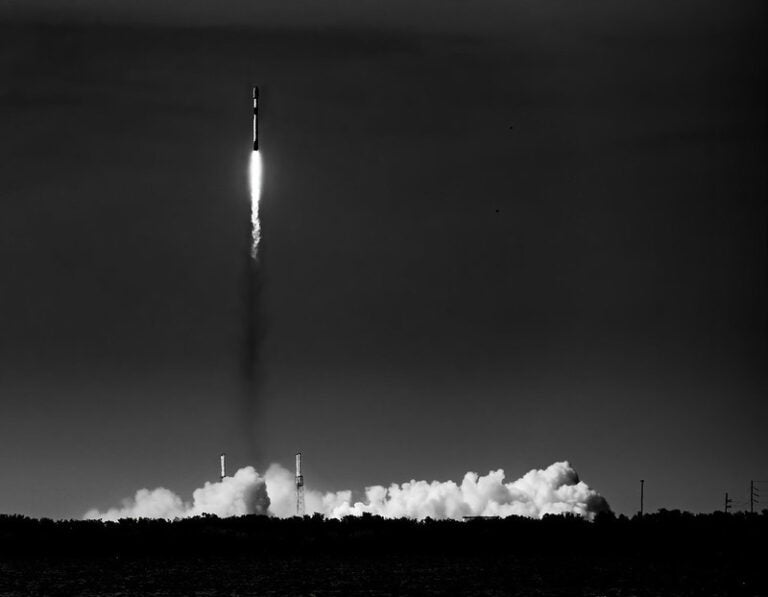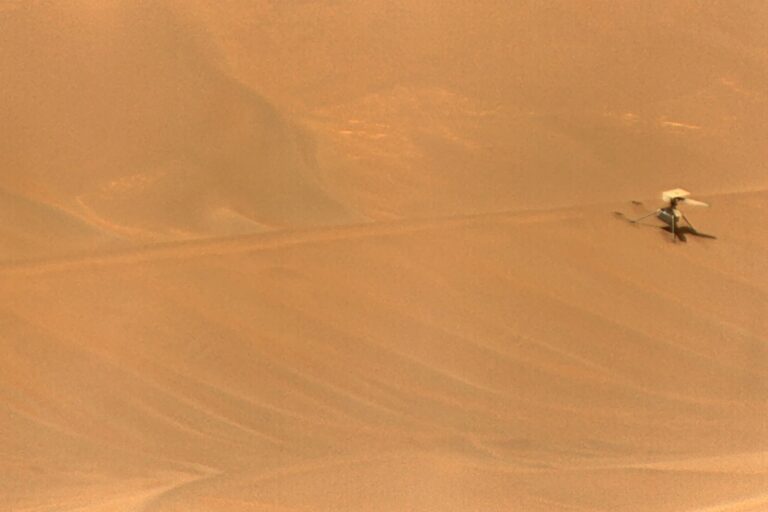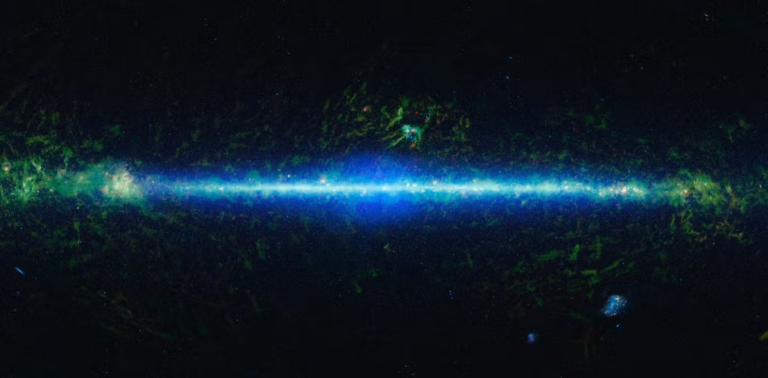In total, NASA has three spacecraft presently scrutinizing the Moon: the well-equipped Lunar Reconnaissance Orbiter (LRO) and a pair of recycled twin satellites called ARTEMIS-P1 and ARTEMIS-P2. Thanks to these missions, as well as China’s productive Chang’e lunar program and India’s Chandrayaan-1 lunar probe, we now have a better understanding of the Moon than we’ve ever had before, and that’s key to helping us determine the ideal place to send a crew.
The highs and lows of the Moon’s rugged southern hemisphere shine through in this false-color topographic image. Red indicates high elevation outcrops and crater rims, whereas the deepest blues show the bottoms of ancient craters that may hold water ice, a key resource for future explorers.
The Lunar Reconnaissance Orbiter
A decade ago, the Lunar Reconnaissance Orbiter blasted off from Florida’s Cape Canaveral. After traveling some 240,000 miles (386,000 kilometers) to reach the Moon, LRO began its primary mission: exploring the lunar surface to help support future crewed and robotic missions.
Now, 10 years and over a petabyte of data later, LRO has cemented itself as one of the most prolific NASA missions to date. It’s not only mapped the lunar surface in terrific detail, achieving over 98 percent coverage, it’s also made a host of scientific discoveries that will inform and inspire research and exploration for years to come.
The majority of LRO’s seven main instruments were designed to bring the lunar surface into sharper focus than ever before. LRO circles the Moon’s poles multiple times each day and studies the surface through a host of different wavelengths, including infrared, ultraviolet, and optical. These new observations have revealed a slew of intriguing sites ripe for future astronauts to explore.
One of the most tantalizing spots sits near the Moon’s south pole at a 12-mile-wide (19 kilometer) impact site known as Shackleton Crater. Here, LRO has identified a handful of places along the crater’s rim that are hit with near-constant sunlight thanks to the Moon’s slight tilt. And because an extended trip to the Moon will likely rely on solar power, these sunbathed sites, or similar illuminated crater rims, could be ideal places to generate electricity.
And these well-lit crater rims also point the way to sites that are valuable for the opposite reason: their crater floors can be constantly shrouded in shadow. According to LRO data, the frigid bottoms of some crater floors near the lunar poles are never in direct sunlight. Reaching temperatures as cold as -400 degrees Fahrenheit (-240 degrees Celsius), the bottoms of these craters are even chillier than Pluto. Luckily for future lunar inhabitants, this also makes the crater bottoms perfect reservoirs for water-ice.
Future lunar explorers could eventually mine and convert the ice into drinking water. They may even be able to transform it into breathable oxygen and spacecraft propellant. After all, a major motivation for going to the Moon is to one-day set up a sort of cosmic filling station, where spacecraft and probes can top off their fuel tanks before venturing farther out into the solar system.
LRO, however, hasn’t only been on the hunt for ideal locations for future lunar missions. It’s also taken some time to appreciate the past. Since 2011, LRO has explored several Apollo landing sites thanks to a dipping orbit that plunges the spacecraft to within about 15 miles (24 km) of the lunar surface. Such maneuvers help put into perspective just how little of the Moon we’ve actually covered in person. LRO’s exquisite resolution can even reveal the footsteps and equipment Apollo astronauts left behind.
NASA expects the spacecraft to continue scanning our satellite for at least a few more years as it helps the space agency prepare for humanity’s first trip to the Moon in nearly half a century.
LRO isn’t NASA’s only lunar probe. Another, largely under-the-radar mission, is currently being carried out by a duo of repurposed NASA spacecraft.
The ARTEMIS mission (short for Acceleration, Reconnection, Turbulence, and Electrodynamics of the Moon’s Interaction) is a spin-off of a former Earth-orbiting project named THEMIS. The original THEMIS mission saw five identical probes launched into Earth orbit in early 2007.
The probes studied how charged particles streaming from the Sun interact with Earth’s magnetic field. At the conclusion of THEMIS’ primary mission in 2009, NASA decided to try reassigning two of the craft, which were having trouble keeping power in Earth’s shadow. And scientists thought the repurposed spacecraft could help them learn about the magnetic mysteries of the Moon.
The probes performed a series of maneuvers that transferred them from Earth orbit to their intended destinations near the Moon. They’ve spent the last seven years closely studying how the Moon interacts with the solar wind and Earth’s magnetosphere.
For example, researchers have used ARTEMIS to study a mysterious feature of the Moon known as its plasma wake. This is a turbulent cavity in space where the solar wind is blocked by the Moon itself, which can lead to some interesting effects. Plasma wakes can trickle electrical charge onto the lunar surface, presenting a potentially dangerous discharge hazard for the spacesuits of future astronauts.
Researchers are also interested in using ARTEMIS to learn more about an extended region of our planet’s magnetic field — called a magnetotail — that the solar wind pushes to well beyond the orbit of the Moon. ARTEMIS discovered that reconnection events in the magnetotail hurl unstable jets of charged particles toward our planet. These particles kickstart auroras on Earth and might endanger travelers headed to the Moon. According to a NASA statement, “The more we understand about how those particles are accelerated, the better we can protect our spacecraft and astronauts as we explore deeper into the solar system.”
ARTEMIS isn’t done just yet. Earlier this year, it explained the cause of an odd Moon phenomenon described as “sunburn.” On Earth, our magnetic field blocks most particles streaming from the Sun. The Moon doesn’t have that protection. And the constant bombardment by high-energy particles darkens the lunar soil. However, even though the Moon doesn’t have a global magnetic field, its surface is speckled with magnetized rocks. And these isolated yet relatively weak magnetic fields can span hundreds of miles, providing bubbles of protection from the solar wind.
“The magnetic fields in some regions are locally acting as this magnetic sunscreen,” Andrew Poppe of UC-Berkeley, who uses ARTEMIS data to study the Moon’s surface magnetic fields, said in press materials. “Sometimes you put on sunscreen and you miss a tiny little bit, and then you have a really bright red spot on your skin.”
A similar process is happening on the Moon. As the charged particle stream toward the surface, they are deflected around the localized magnetic bubbles, leaving distinct light splotches of unadulterated regolith. Although such magnetic hotspots are too weak to shield future lunar astronauts from all the dangers of the solar wind, by studying their structure, researchers hope to develop more effective ways of protecting the next wave of explorers from radiation as they tread across the surface of the Moon.
Artemis, NASA’s crewed mission
And while long-term lunar probes are an affordable way to explore the lunar surface, they don’t carry the same punch as a crewed mission. That’s NASA’s next step.
Like the repurposed ARTEMIS probes, NASA’s new Artemis mission has its sights set for the Moon. The Trump administration says that the first crewed lunar mission in half a century could happen by 2024, though it’s not yet clear how the space agency would pay for it. And following that, NASA plans to carry out a series of missions to prepare for “a sustained human presence on and around the Moon by 2028.”
So buckle up, because humanity’s next trip to the Moon may soon get underway.

